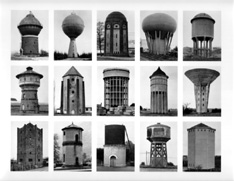Schaden.com - Projects * Publishing * for International Contemporary Photography

Typologien
HC, 30 x 30 cm., 276 pp., 130 Duotones -
1528 Einzelbilder
Schirmer/Mosel 2003
1528 Einzelbilder
Schirmer/Mosel 2003
"We wanted to provide a viewpoint or rather a grammar for people to understand and compare different structures." Bernd Becher
View + Discuss
1. Name some things you notice about this work by Bernd and Hilla Becher. What are some things that are similar about the images? Different?
2. Describe how they have organized this work. What difference would it have made if they had used different size images or not arranged them in rows?
3. The Bechers often focus on architectural structures as the subject of their work. Name some examples of architectural structures you see everyday. What do you think the Bechers found interesting about these structures?
4. An important principle in architecture has been that a building/structure's form follows its function. What do you think is meant by that? The title of this work is Water Towers. What is the function of a water tower? How does this function influence the shape or form of these towers?
5. In some ways, this work is a combination of different art forms?architecture, sculpture, and photography. How does each of these art forms relate to this work?
6. Look at the photographs. Describe the similarities between them. How are they different from each other?
7. The Bechers are also important professors of art. Let's review an assignment they gave to their students and discuss how each of these steps relates to Water Towers.
-Choose a subject that is plentiful or abundant, preferably a type of architecture. The subject should be something that relates to people rather than nature.
-Make your work in the same way every time?if possible, have no clouds, focus on the front of the subject, and with no movement or emotion suggested
-Make a large number of pictures that show different examples of the same subject.
Why might an artist have such a specific way of doing things? Can you think of an example where following the same set of instructions or practicing over and over again has improved what you do (for example, shooting a basket, hitting a baseball, handwriting, swimming lessons)? The Bechers believe that this kind of practice is necessary for creating art as well.
--Guggenheim.org
View + Discuss
1. Name some things you notice about this work by Bernd and Hilla Becher. What are some things that are similar about the images? Different?
2. Describe how they have organized this work. What difference would it have made if they had used different size images or not arranged them in rows?
3. The Bechers often focus on architectural structures as the subject of their work. Name some examples of architectural structures you see everyday. What do you think the Bechers found interesting about these structures?
4. An important principle in architecture has been that a building/structure's form follows its function. What do you think is meant by that? The title of this work is Water Towers. What is the function of a water tower? How does this function influence the shape or form of these towers?
5. In some ways, this work is a combination of different art forms?architecture, sculpture, and photography. How does each of these art forms relate to this work?
6. Look at the photographs. Describe the similarities between them. How are they different from each other?
7. The Bechers are also important professors of art. Let's review an assignment they gave to their students and discuss how each of these steps relates to Water Towers.
-Choose a subject that is plentiful or abundant, preferably a type of architecture. The subject should be something that relates to people rather than nature.
-Make your work in the same way every time?if possible, have no clouds, focus on the front of the subject, and with no movement or emotion suggested
-Make a large number of pictures that show different examples of the same subject.
Why might an artist have such a specific way of doing things? Can you think of an example where following the same set of instructions or practicing over and over again has improved what you do (for example, shooting a basket, hitting a baseball, handwriting, swimming lessons)? The Bechers believe that this kind of practice is necessary for creating art as well.
--Guggenheim.org
